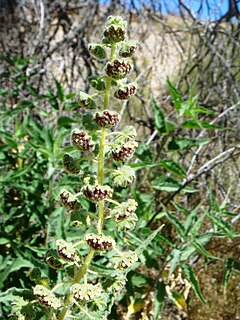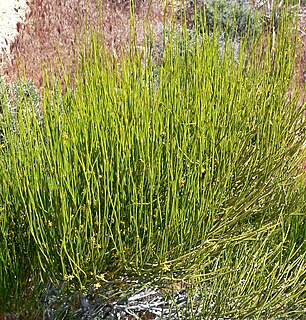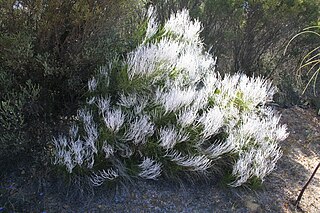
Larrea tridentata, called creosote bush and greasewood as a plant, chaparral as a medicinal herb, and gobernadora in Mexico. It is Spanish for "governess", due to its ability to secure more water by inhibiting the growth of nearby plants. In Sonora, it is more commonly called hediondilla; Spanish hediondo = "smelly".

Encelia farinosa, is a common desert shrub of northern Mexico and the southwestern United States.

Shrubland, scrubland, scrub, brush, or bush is a plant community characterized by vegetation dominated by shrubs, often also including grasses, herbs, and geophytes. Shrubland may either occur naturally or be the result of human activity. It may be the mature vegetation type in a particular region and remain stable over time, or a transitional community that occurs temporarily as the result of a disturbance, such as fire. A stable state may be maintained by regular natural disturbance such as fire or browsing. Shrubland may be unsuitable for human habitation because of the danger of fire. The term was coined in 1903.

Parkinsonia microphylla, the yellow paloverde, foothill paloverde or little-leaved palo verde; syn. Cercidium microphyllum), is a species of palo verde.

Parkinsonia florida, the blue palo verde, is a species of palo verde native to the Sonoran Deserts in the Southwestern United States and Northwestern Mexico. Its name means "green pole or stick" in Spanish, referring to the green trunk and branches, that perform photosynthesis.

Prosopis glandulosa, commonly known as honey mesquite, is a species of small to medium-sized, thorny shrub or tree in the legume family (Fabaceae).

Ambrosia ambrosioides, also known as canyon ragweed or chicura, is a ragweed found in the deserts of northern Mexico, Arizona, and California.

Baccharis sarothroides is a North American species of flowering shrub known by the common names broom baccharis, desertbroom, greasewood, rosin-bush and groundsel in English and "escoba amarga" or "romerillo" in Spanish. This is a spreading, woody shrub usually sticky with glandular secretions along the primarily leafless green stems. The small, thick leaves are a few centimeters long and are absent much of the year, giving the shrub a spindly, twiggy appearance. It flowers abundantly with tiny green blooms on separate male and female plants.

Ephedra viridis, known by the common names green Mormon tea, green ephedra, and Indian tea, is a species of Ephedra. It is indigenous to the Western United States, where it is a member of varied scrub, woodland, desert, and open habitats. It grows at 900–2,300 metres (3,000–7,500 ft) elevations.

Trixis californica , the American threefold or American trixis, is a species of flowering plant in the family Asteraceae. It is native to the southwestern United States in California, Arizona, New Mexico, and Texas, and in Mexico in the states of Baja California, Chihuahua, Coahuila, Durango, Nuevo León, Sinaloa, Sonora, Tamaulipas, and Zacatecas.

Krameria bicolor is a perennial shrub or subshrub of the family Krameriaceae, the rhatanies. It is commonly known as white rhatany, crimson-beak, and chacate in Spanish. It is found in drier environments of the southwestern United States from California to Texas, and in northern Mexico.

Krascheninnikovia lanata is a species of flowering plant in the family Amaranthaceae, known by the common name winterfat. It is native to much of western North America: from central Western Canada; through the Western United States; to northern Mexico.

Leptadenia pyrotechnica is the botanical name of a desert herb of the family Apocynaceae. It is widespread from Senegal to India. It is known as khimp in Hindi and Urdu,"Khipp" in Punjabi.

Phoradendron californicum, the desert mistletoe or mesquite mistletoe, is a hemiparasitic plant native to southern California, Nevada, Arizona, Sonora, Sinaloa and Baja California. It can be found in the Mojave and Sonoran Deserts at elevations of up to 1400 m.

Porophyllum gracile is a species of flowering plant in the aster family known by the common names odora and slender poreleaf. It is native to northern Mexico and the southwestern United States from California to Texas, where it can be found in rocky and sandy desert scrub habitat.

Ziziphus obtusifolia is a species of flowering plant in the buckthorn family known by several common names, including lotebush, graythorn, gumdrop tree, and Texas buckthorn.

Lycium berlandieri is a species of flowering plant in the nightshade family known by the common name Berlandier's wolfberry. It is native to Mexico and the south-western United States from Arizona to Texas.

Lycium shawii, desert thorn or Arabian boxthorn is a species of thorny shrub adapted to desert environments, and can be found throughout the Arabian peninsula, and some places in Africa. The thin leaved, rigid bush grows up to 3 metres high, with a lot of branches and alternating spines that vary in size, and grow along the branches and on their tips. The leaves narrow towards their base. It produces small whitish-pink or purple flowers from September until April, and red pea-sized seedy berries that are edible. Habitats include gravel plains and foothills up to 4,000 ft (1,200 m), as well as wadis. Plants often growing nearby include Acacia tortilis and Prosopis cineraria.
Grevillea spinosa, also known as the spiny grevillea, is an evergreen shrub of the genus Grevillea native to an area in the east of the Mid West, northern Goldfields-Esperance and southern Pilbara regions of Western Australia.

Conospermum triplinervium, commonly known as the tree smokebush or elk smokebush, is a tree or shrub endemic to Western Australia.


















